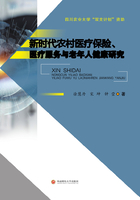
Abstract
Since the Eighteenth National Congress of the Communist Party of China, the Party Central Committee, with President Xi Jinping as its general secretary, has sounded the call of the times for building a healthy China, which is based on the long-term development of the country and aiming at the great rejuvenation of the nation. The outline and plan of the CPC Central Committee for a healthy China is primarily concerned with the health of the people. Over the past 30 years, China has made remarkable achievements in the field of health. The average life expect-ancy of residents has increased from 35 years old in the founding of New China to 76.34 in 2015. The maternal mortality rate has decreased from 1500 in hundred thousandth in 1949 to 20.1 in 2015. The infant mortality rate has decreased from 200 in thousandth in the early years of New China to 8.1 in 2015. These three in-ternationally-accepted indicators of health have witnessed the glorious health de-velopment in a large developing country with a large population. In addition, China's rural health infrastructure investment has increased significantly, the grass-roots medical and health service system has been strengthened, the equalization of basic public health services has been continuously promoted, the reform of public hospitals has been deepened, the accessibility of medical and health services has been more balanced, and the fairness and affordability of services have been improved.
The new rural cooperative medical system(hereinafter named by NRCMS)has been an important reform of the rural medical and health system in China since the reform and opening up. Since the start of the NRCMS in 2003, Chinese govern-ment has increased the subsidies for several times. The participation rate of the new rural cooperative medical system has increased year by year, which have covered-most rural families. Meanwhile, with the development of urbanization in China, the number of rural migrant workers is increasing, which results in a large group of the elderly leftbehind in rural areas. The elderly in rural areas suffered from rapid health impairment in yearly agricultural work, andthereforefaced more healthy risks. On the implementation effect of the new rural cooperative medical system, most studies have different results. Whether the current rural medical system has been improved the health status of rural population, especially the elderly, is a matter of concern.
Based on the theories ofscientific development, new institutional economics, health economics and so on, this paper comprehensively evaluates and analyzes the performance and action mechanism of NRMCSon the elderly by using statistical a-nalysis and PSMDID as well. This paper adopts the dataset of Chinese longitudinal health Longevity Surveyin 2011 and 2014, to analyze the health status of the elderly in rural areas of China, to evaluate whether NRMCS affects health status of the elderly in rural areas, and to measurethe impactof NRMCS. Additionally, based on the field survey data of 5 towns and 10 villages in rural areas of Jialing District of Sichuan Province, this article analyzed the current situation of medical and health system development and health service supply in Jialing District, and makes an empirical analysis through descriptive statistics, correlation analysis, multi-classification ordered logit regression and multiple linear regression. On the results, this paper put forward some suggestions on bettering rural medical syste-mand integrating urban and rural medical insurance.
This paper concludes that:(1)by analyzing the development of rural medical service supply and rural medical insurance system in China, it is obvious that the supply of rural medical and health services has been increased rapidly, with con-tinuous improvement of the life expectancy, the maternal and infant mortality rates. The new rural cooperative medical insurance system is helpful to the healthof rural residents.(2)The statistical analysis of CLHLS database in 2011 and 2014 shows that the self-rated health of the NRMCS participants decreased, whiletheirphysical deterioration is relatively slow compared with the controlled group. The availability and the utilization rateof medical services wereimproved. Compared with the con-trolled group, the elderly in the participating group drank more alcohol and exer-cised less, which may result in moral hazards.(3)The empirical results of PSM-DID model show that the new rural cooperative medical system improves the health status of rural elderly by 2.69-7%, decreases the times of serious illnesses by 0.21, reduces the bedridden days by 6-9 days, and significantly reduces the med-ical expenditure of participants. Timely medical assistance and actual medical expenditure are important factors affecting the health status of participants.(4)Bases on the empirical analysis of field investigation in Jialing District of Si-chuan Province, we concluded that: in self-assessment, the number of chronic diseases is positively correlated with health self-assessment index. Income self-as-sessment is not significant, but the growth of household expenditure will signifi-cantly increase the health pressure of respondents. Age, education, marriage, the number of children, smoking, drinking and insurance had no significant impact, while gender was the most significant factor in the control variables. In terms of sat-isfaction with medical services, only income is significantly negative coefficient, and self-treatment is significantly negative. In terms of one-year medical expenses, the number of chronic diseases is positively correlated with the number of chronic diseases, and whether to carry out chronic treatment is negatively corre-lated.
Based on above conclusions, consideringthe present integration of urban and rural medical insurance system in China, this paper puts forward the following sug-gestions:(1)to properly increase the reimbursement ratio of medical system, to expand the areas of reimbursement, to simplify reimbursement procedures, and re-duce actual medical expenses.(2)to strengthen medical service supply, improve the quality of medical service and improve subsidies of medical service in rural areas.(3)to furtherlypromote the integration of urban and rural medical insurance.(4)to improve preventive health care system, reducing the cost of self-treatment, increasing the reimbursement intensity and scope of medical insurance, caring for the health of rural elderly women, speeding up the implementation of graded diag-nosis and treatment system, and increasing the supply of primary medical services are very important.
Keywords: new rural cooperative medical system; health of the elderly; per-formance; medical service